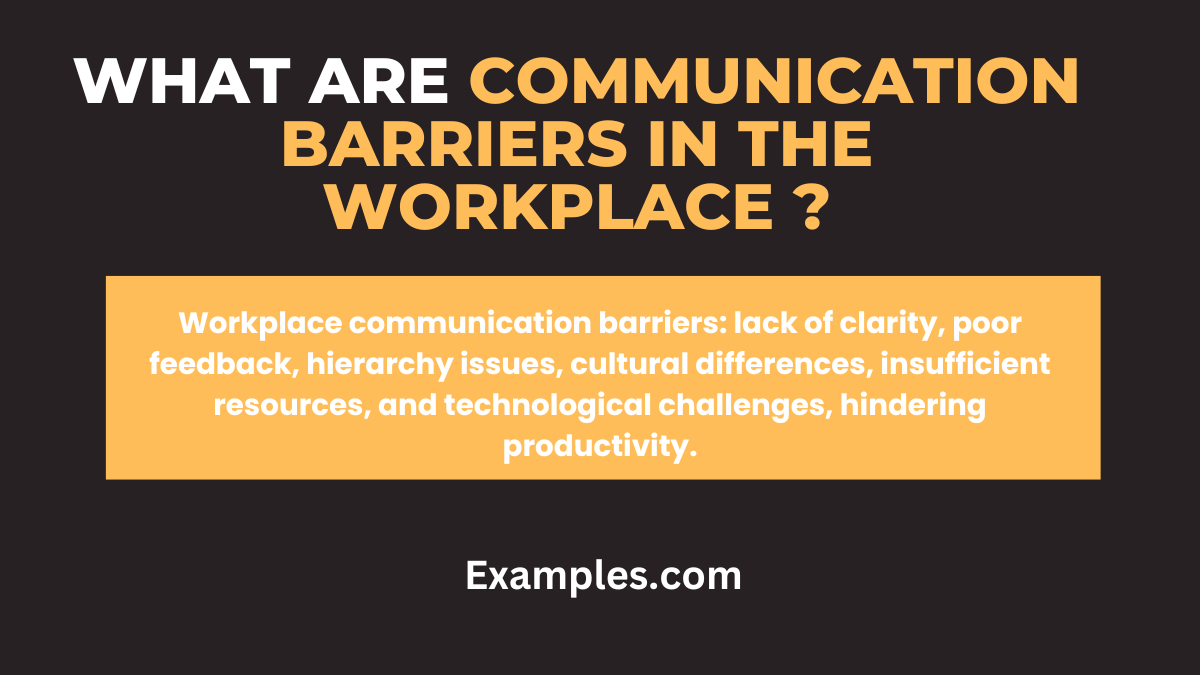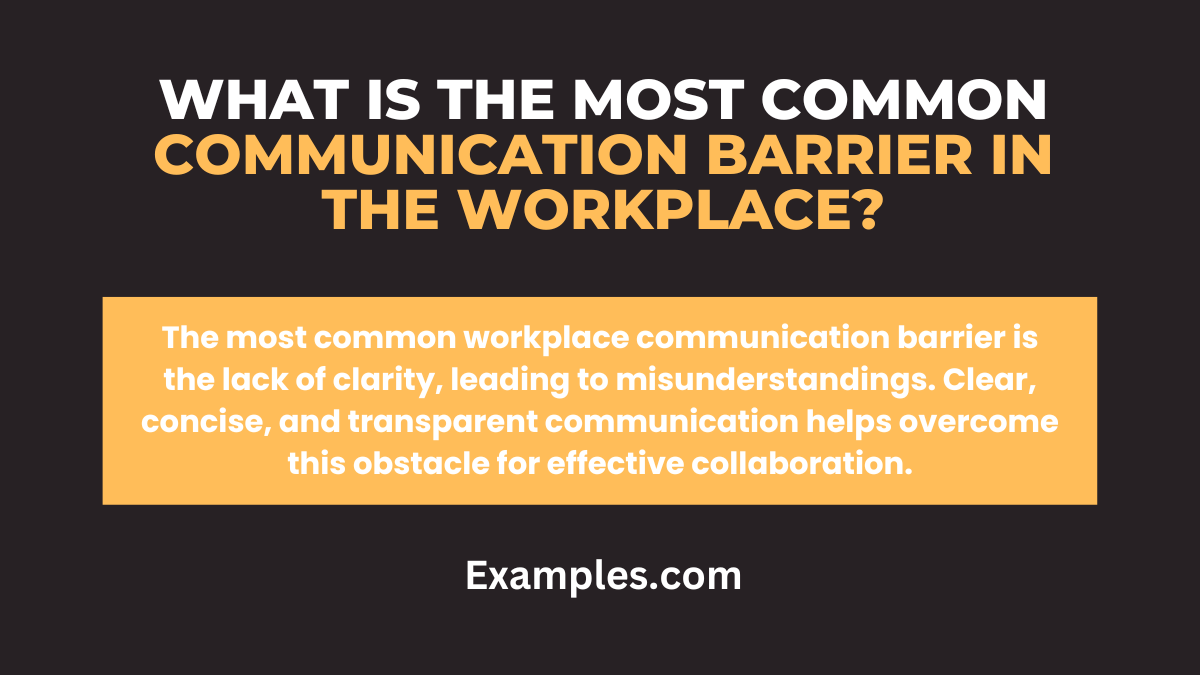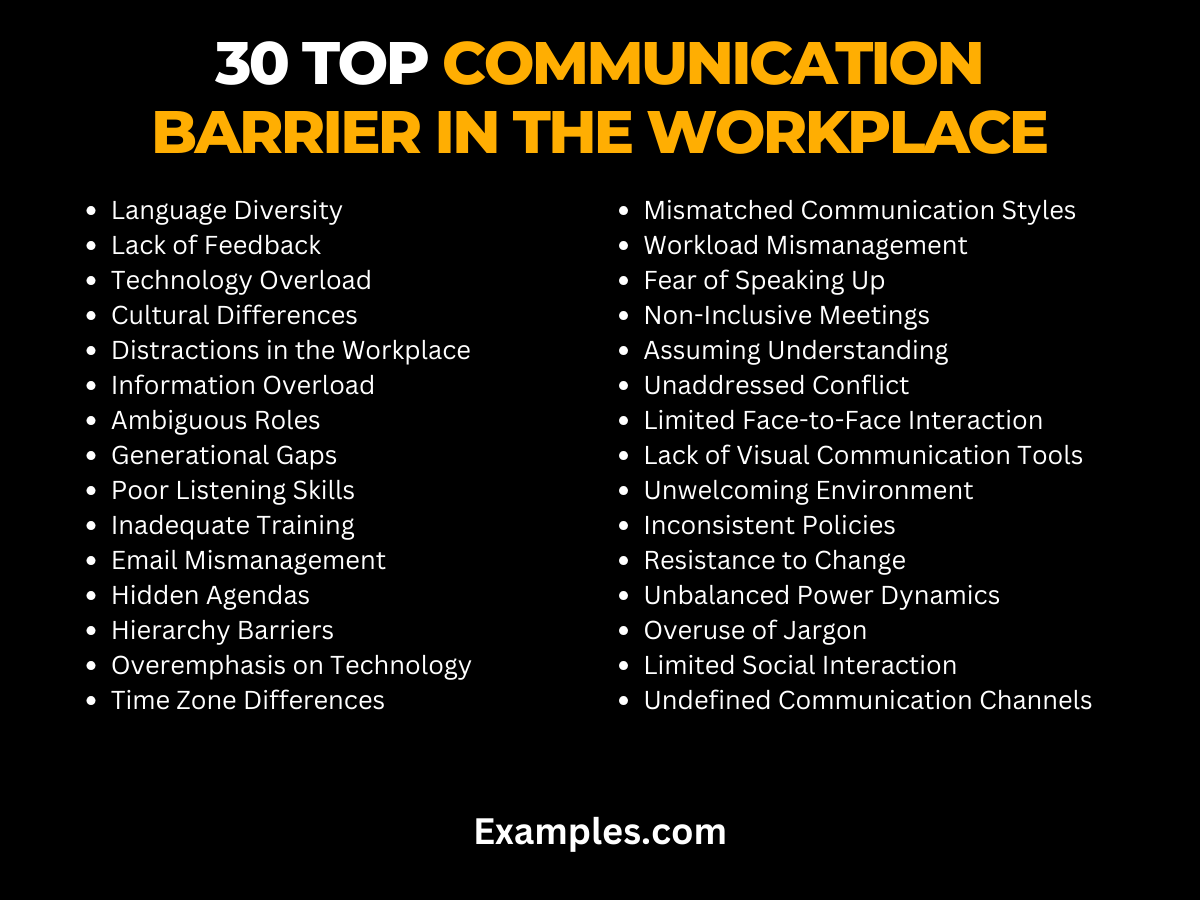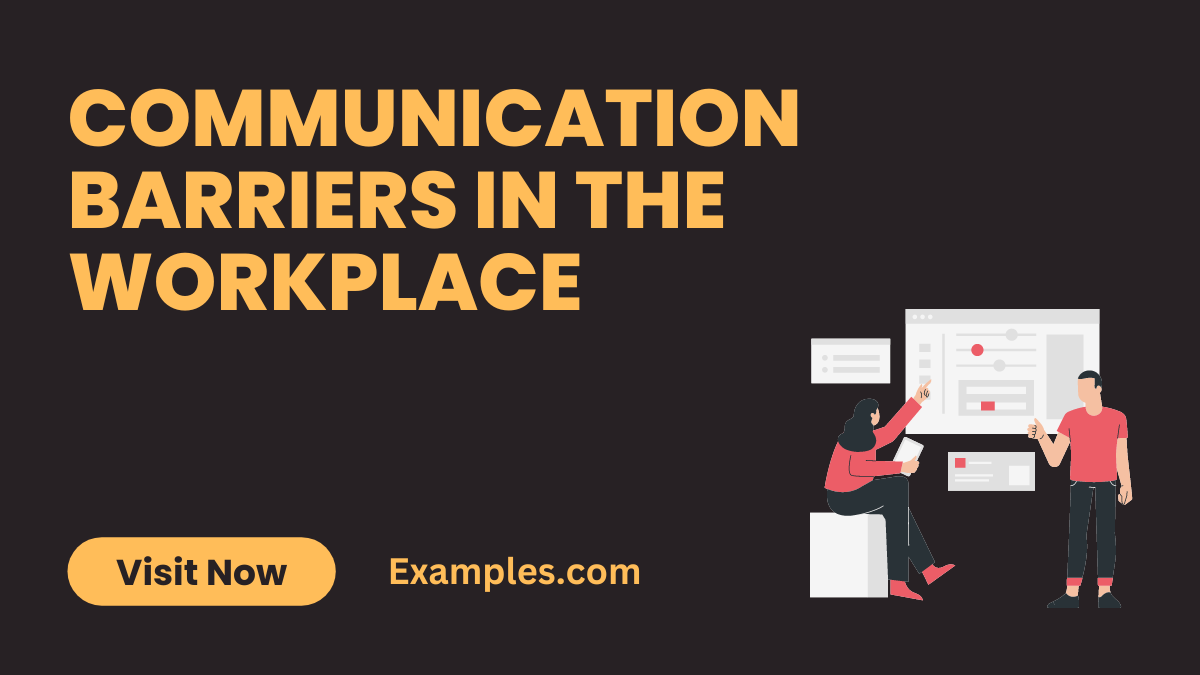29+ Communication Barriers in the Workplace Examples
Unlock seamless workplace interactions with our Comprehensive Guide on Communication Barriers. Overcome obstacles hindering productivity and team synergy. Delve into practical Communication Examples illustrating effective strategies. Elevate your team’s success by identifying and dismantling barriers. Empower your workforce with the tools to foster a communicative environment. Boost collaboration and cohesion for sustained growth. Explore the key insights to break through workplace communication challenges. Maximize efficiency and elevate your team’s performance today.
What are Communication Barriers in the Workplace?

Communication barriers in the workplace refer to obstacles that hinder the free flow of information between individuals or teams. These barriers can manifest as language differences, misunderstandings, or physical barriers, impeding effective communication. Recognizing and addressing these obstacles is crucial for fostering a collaborative and productive work environment. By breaking down these barriers, organizations can enhance teamwork, reduce conflicts, and promote a culture of open and transparent communication.
What is the Most Common Communication Barrier in the Workplace?

The pervasive communication barrier in the workplace often revolves around a lack of clarity. This manifests in unclear messages, ambiguous expectations, and vague instructions. Misunderstandings arise when information is not conveyed explicitly, leading to confusion, errors, and strained relationships. Overcoming this barrier involves fostering a culture of clear communication, emphasizing the importance of concise and unambiguous messaging. By addressing this common challenge, organizations can enhance efficiency, reduce conflicts, and cultivate a more cohesive work environment.
30 Top Communication Barrier in the Workplace

Unlock workplace harmony by navigating these common communication barriers. From language discrepancies to technological hiccups, each obstacle demands a tailored solution for seamless collaboration. Discover effective strategies to overcome these challenges and foster a culture of clear communication, boosting productivity and team cohesion.
- Language Diversity
- Challenge: Differing languages hinder understanding.
- Solution: Promote language training and encourage multilingual support.
- Lack of Feedback
- Challenge: Absence of constructive feedback stunts growth.
- Solution: Implement regular feedback sessions and open communication channels.
- Technology Overload
- Challenge: Overreliance on digital platforms creates disconnect.
- Solution: Balance digital and face-to-face communication, ensuring inclusivity.
- Cultural Differences
- Challenge: Varied cultural norms impact interpretation.
- Solution: Foster cultural awareness through training and inclusivity programs.
- Distractions in the Workplace
- Challenge: External disruptions impede focus.
- Solution: Create designated quiet zones and implement focus-friendly policies.
- Information Overload
- Challenge: Excessive data hampers comprehension.
- Solution: Prioritize essential information and streamline communication channels.
- Ambiguous Roles
- Challenge: Unclear responsibilities lead to confusion.
- Solution: Clearly define roles and responsibilities for each team member.
- Generational Gaps
- Challenge: Diverse age groups interpret messages differently.
- Solution: Facilitate intergenerational workshops to bridge communication styles.
- Poor Listening Skills
- Challenge: Inattentiveness disrupts understanding.
- Solution: Conduct workshops to enhance active listening skills.
- Inadequate Training
- Challenge: Lack of communication training hampers efficiency.
- Solution: Invest in comprehensive communication skills training programs.
- Email Mismanagement
- Challenge: Poorly crafted emails lead to misunderstandings.
- Solution: Provide email etiquette guidelines and encourage clarity.
- Hidden Agendas
- Challenge: Concealed motives hinder transparent communication.
- Solution: Foster a culture of openness and trust within the team.
- Hierarchy Barriers
- Challenge: Hierarchical structures impede open dialogue.
- Solution: Encourage open-door policies to facilitate communication across all levels.
- Overemphasis on Technology
- Challenge: Over-reliance on digital communication excludes personal touch.
- Solution: Integrate face-to-face meetings for crucial discussions.
- Time Zone Differences
- Challenge: Global teams struggle with synchronized communication.
- Solution: Implement flexible working hours and asynchronous communication tools.
- Mismatched Communication Styles
- Challenge: Varied communication preferences lead to confusion.
- Solution: Conduct assessments and provide communication style guides.
- Workload Mismanagement
- Challenge: Overburdened employees struggle to communicate effectively.
- Solution: Optimize workloads and establish realistic deadlines.
- Fear of Speaking Up
- Challenge: Team members hesitate to voice concerns.
- Solution: Cultivate a culture that values diverse opinions and encourages feedback.
- Non-Inclusive Meetings
- Challenge: Some team members feel excluded during meetings.
- Solution: Ensure inclusivity by soliciting input from all participants.
- Assuming Understanding
- Challenge: Assuming everyone comprehends without confirmation.
- Solution: Implement a feedback loop to verify understanding.
- Unaddressed Conflict
- Challenge: Unresolved conflicts hinder open communication.
- Solution: Establish a conflict resolution process and encourage open dialogue.
- Limited Face-to-Face Interaction
- Challenge: Exclusively virtual communication lacks personal touch.
- Solution: Arrange periodic face-to-face meetings for better connection.
- Lack of Visual Communication Tools
- Challenge: Inability to express ideas visually hampers understanding.
- Solution: Integrate visual aids and collaboration tools for clearer communication.
- Unwelcoming Environment
- Challenge: Uninviting spaces deter open communication.
- Solution: Foster a positive and inclusive work environment.
- Inconsistent Policies
- Challenge: Unclear or changing policies create confusion.
- Solution: Regularly update and communicate policies transparently.
- Resistance to Change
- Challenge: Resistance impedes the adoption of new communication methods.
- Solution: Provide training and communicate the benefits of change effectively.
- Unbalanced Power Dynamics
- Challenge: Power imbalances hinder open communication.
- Solution: Promote equality and fairness in communication channels.
- Overuse of Jargon
- Challenge: Technical language alienates non-experts.
- Solution: Clarify jargon in communications and encourage plain language.
- Limited Social Interaction
- Challenge: Lack of informal communication hampers team bonding.
- Solution: Organize team-building events and encourage socialization.
- Undefined Communication Channels
- Challenge: Unclear channels lead to message distortion.
- Solution: Establish and communicate standardized channels for different types of communication.
What are the Communication Issues in the Workplace?
Effective communication is the cornerstone of a successful workplace, but various barriers can impede this vital process. Identifying and addressing these communication issues is crucial for fostering a collaborative and productive environment. Below, we delve into key communication challenges encountered in the workplace, offering insights and strategies for overcoming them.
1. Lack of Clarity and Ambiguity
One prevalent issue is the lack of clarity in communication, leading to misunderstandings and confusion. Ambiguous messages, vague instructions, and unclear expectations contribute to this barrier. To address this, organizations should emphasize the importance of clear, concise communication and provide guidelines on crafting unambiguous messages.
2. Poor Listening Skills
Communication is a two-way street, and poor listening skills can hinder effective workplace interactions. When team members fail to actively listen, misunderstandings arise, and vital information is missed. Encouraging and training employees in active listening techniques is essential for overcoming this issue.
3. Cultural and Language Differences
In diverse workplaces, cultural and language disparities can create communication challenges. Different cultural norms and language barriers may lead to misinterpretations and hinder collaboration. Cultural sensitivity training and language support programs can bridge these gaps and foster a more inclusive atmosphere.
4. Technological Overload
While technology enhances communication, overreliance on digital platforms can lead to information overload and a disconnect among team members. Balancing technology use with face-to-face interactions and implementing clear guidelines for digital communication can mitigate this issue.
5. Lack of Feedback and Constructive Criticism
The absence of regular feedback hampers professional growth and contributes to communication breakdowns. Establishing a culture of open feedback, including both positive and constructive criticism, helps create a supportive environment for continuous improvement.
6. Resistance to Change
Resistance to adopting new communication methods or technologies is a common hurdle. Organizations should proactively communicate the benefits of changes, provide training, and involve employees in the decision-making process to reduce resistance and enhance adaptation.
7. Hierarchical Barriers
Hierarchical structures can inhibit open communication, with lower-level employees hesitant to share their thoughts or concerns with higher-ups. Implementing open-door policies, regular team meetings, and fostering an inclusive culture encourages communication across all levels.
8. Information Overload
An excess of information can overwhelm employees, hindering their ability to process critical details. Streamlining communication channels, prioritizing essential information, and utilizing clear, concise messaging help prevent information overload.
9. Lack of Personal Interaction
Exclusively digital communication can lead to a lack of personal connection among team members. Encouraging face-to-face interactions, whether in-person or through video conferencing, strengthens relationships and promotes a more cohesive team.
10. Inconsistent Communication Policies
Unclear or inconsistent communication policies contribute to confusion and misalignment. Regularly updating and transparently communicating policies ensures that all team members are on the same page, promoting a unified understanding
What are the Barriers of Communication in Business Organizations?
Delve into the intricate landscape of communication issues within professional environments, unraveling the complexities that hinder effective workplace communication. This guide offers strategic insights and practical solutions to navigate and overcome these challenges.
1. Ambiguity and Lack of Clarity: Unmasking Misunderstandings
Explore the subtle disruptors of workplace communication—vague messages and unclear instructions. Gain a deep understanding of the impact of ambiguity and discover actionable strategies to enhance clarity and promote understanding.
2. Subpar Listening Skills: Breaking the Silence
Investigate the repercussions of inadequate listening skills in the workplace. Discover the transformative power of active listening and explore techniques and training programs designed to elevate the listening capabilities of your team.
3. Cultural and Language Disparities: Bridging Global Divides
Examine the challenges posed by cultural and language differences in diverse workplaces. Navigate through the nuances of cultural sensitivity training and language support strategies to cultivate an inclusive environment fostering cross-cultural understanding.
4. Technological Overload and Disconnect: Striking Digital Harmony
Balance the advantages of technology with the pitfalls of information overload. Navigate the challenges associated with digital communication platforms and explore methods to ensure a harmonious integration of technology and interpersonal connections.
5. Feedback Void and Constructive Criticism: Cultivating Growth
Uncover the impact of a dearth of feedback on professional development. Learn how to instill a culture that embraces both positive and constructive criticism, fostering an environment conducive to continuous improvement.
How do Communication Barriers affect the Workplace?
Communication barriers can significantly impact the workplace environment in various ways, hindering productivity and harmony among employees. These barriers can manifest in different forms and have distinct consequences. Here’s a breakdown of how communication barriers affect the workplace:
- Reduced Productivity: When communication is not clear or effective, tasks take longer to complete. Misunderstandings can lead to errors, rework, and wasted time.
- Conflict and Tension: Poor communication often leads to misunderstandings, disagreements, and conflicts among team members. These conflicts can harm working relationships and create a negative atmosphere in the workplace.
- Low Morale: Employees who feel unheard or undervalued due to communication barriers may become demotivated and disengaged. This can lead to a decrease in overall morale within the organization.
- Mistakes and Errors: Miscommunication can result in mistakes and errors in work processes, leading to financial losses and damage to the company’s reputation.
- Inefficiency: Lack of clear communication can lead to inefficiency in decision-making processes. Important decisions may be delayed or made without the necessary information.
- Missed Opportunities: When information is not communicated effectively, opportunities for innovation and improvement may be missed. Valuable ideas and insights may go unshared.
- Resistance to Change: Employees may resist changes or new initiatives when they don’t understand the reasons behind them. Effective communication can help ease the transition.
- Customer Satisfaction: External communication barriers can impact how a company interacts with its customers. Poor communication can result in dissatisfied customers and lost business.
- Cultural and Language Differences: In a globalized workplace, cultural and language differences can create communication barriers. It’s essential to bridge these gaps for effective collaboration.
- Loss of Trust: Repeated instances of poor communication can erode trust between employees and between employees and management. Trust is vital for a healthy work environment.
To mitigate these communication barriers, organizations should prioritize clear and transparent communication channels, provide training on effective communication skills, encourage open dialogue, and promote a culture of listening and respect. By addressing communication challenges proactively, workplaces can enhance productivity, reduce conflicts, and create a more positive and collaborative environment for their employees.
Navigating communication barriers in the workplace is essential for fostering a thriving and collaborative environment. By recognizing examples, understanding the effects, identifying signs, and implementing effective solutions, organizations can overcome challenges and promote open, transparent communication. Proactive measures empower teams to build stronger connections, enhance productivity, and cultivate a positive work culture.



